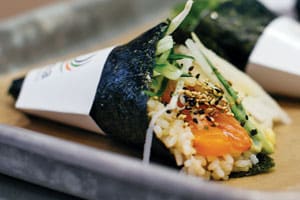Chris Jaeckle is a classically trained chef who honed his skills at renowned New York City restaurant Morimoto before opening his own fine-dining venture, All’onda. Now he’s also a cofounder of New York’s Uma Temakeria, a fast casual that serves temaki, which are cone-shaped, hand-rolled sushi rolls.
Jaeckle, who will be presenting at the Culinary Institute of America’s Worlds of Flavor conference, which this year is focusing on Asian flavors, discusses trends in Asian foods and how Uma Temakeria is taking Japanese cuisine to a whole new level.
What is your thought on the status of Asian flavors in the limited-service environment today?
I don’t really think there’s many options out there. There are a few people playing with it; there’s Sushirrito in San Francisco. But to me, it was sort of a genre that I didn’t think any people were exploring creatively. The market was really starving for it. It shocked me that there was no real other option, that no one had really tried to supply something that’s rice at room temperature or that hasn’t been refrigerated—the things that make a difference in terms of food.
What kinds of Asian flavors do you think are possible in a limited-service format?
I think creativity is limited only by the individual. I don’t think we intend on going further outside the Japanese box than we are already, but I think there are lots of ways to incorporate flavors and profiles: different versions of soy and different versions of kombu and different versions of bonito flakes. There are lots of ways to explore it.
When we think of Asian food in the U.S., we often think of Chinese food. What do you foresee for the future of Japanese food?
I think it’s becoming a staple that’s becoming American, in my opinion, even more so than Chinese food in the fact that the Japanese have begun embracing American culture in terms of their food. You have a Boston Roll, you have a Philadelphia Roll, you have a California Roll; you have these things that are intrinsically becoming American. We were introduced to Chinese food earlier than Japanese food. But I think that as a culture, Americans are embracing Japanese more naturally, and they’re incorporating it into their routines much more consistently. We’re 25 years into sushi being popular in America, and it’s something I believe we haven’t incorporated into our culture.
Rice is such a cornerstone of Japanese cuisine. How would you describe the perfect rice?
That’s a tough question because I love many different versions of rice. In general, the perfect rice is a cuisine thing. In terms of Japanese, in my opinion, it is firm but not al dente, so it still has some texture to it. It’s not toothsome, per se, but it’s not soft and mushy. It also should be able to come apart really easily. So while it is short grain and it’s sticky, it should be seasoned well so that it’s easy to separate. The third portion of it is a nice balance between sweet, sour, and salty.
Customization is really important at Uma Temakeria. How much will customization play into the future of Asian cuisines?
I think it’s what customers want. I’m skeptical in regards to what customers create, in some cases. But that being said, people in our culture want to feel involved. They want to be a part of something, and that certainly allows them to feel that way. I think, intrinsically, that’s very important. We have a lot of repeat customers, and they still want to come back because it makes them feel like they’re part of the process as opposed to just a bystander.
What types of Japanese and Asian ingredients and flavor profiles do you think will become more popular in the next few years?
I see seaweed and kombu coming into their day and age. Not like your basic seaweed salad you get from a Japanese restaurant; I see seaweed salsa verdes happening, and people appreciating the nutritional value of seaweed and kombu. I’m very passionate about it, and I think that’s an ingredient people are going to continue to understand.
As people begin to understand MSG again and what its benefits are, frankly, I think people are going to start embracing that. Kombu is a natural creator of that umami flavor, and you see umami being a buzzword. What umami comes from is MSG, that’s how it’s achieved. I think it’s only a matter of time before kombu and seaweed itself begin to come their own and become a staple in a lot of people’s homes.
Do you think those kinds of ingredients could trickle down to the quick-service and fast-casual categories?
I don’t see why not. Put some kombu in a batch of beans when you cook them in Mexican food; it’s going to change everything about those beans. It imparts so much flavor so naturally that it’s really something I could see moving forward.












